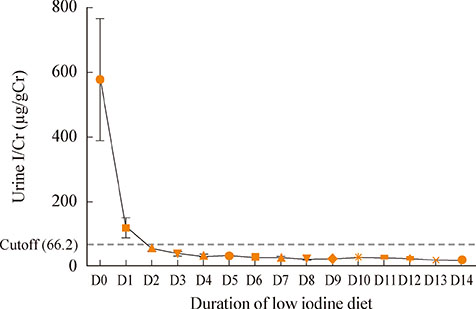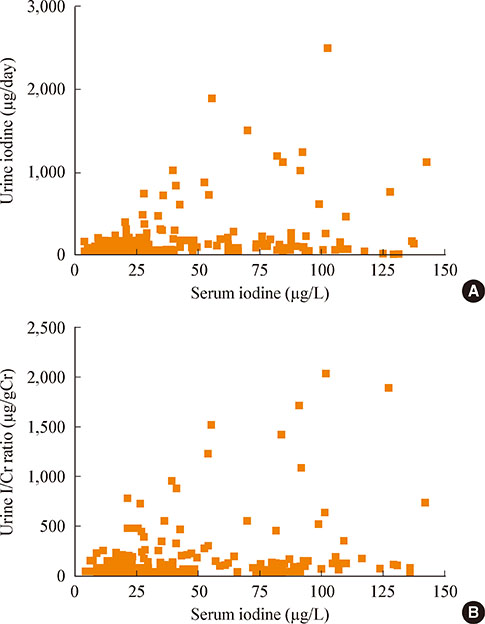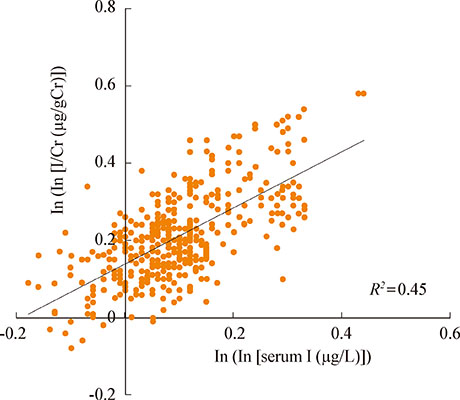Low Iodine Diet for Preparation for Radioactive Iodine Therapy in Differentiated Thyroid Carcinoma in Korea
- Affiliations
-
- 1Division of Endocrinology and Metabolism, Department of Medicine, Samsung Medical Center, Sungkyunkwan University School of Medicine, Seoul, Korea. thyroid@skku.edu
- KMID: 1973818
- DOI: http://doi.org/10.3803/EnM.2013.28.3.157
Abstract
- Preparation for radioactive iodine (RAI) therapy includes an increased serum thyroid stimulating hormone level and a low iodine diet (LID). Because of extremely high iodine intake, some physicians have advocated a more stringent LID for greater than 2 weeks in Korean patients with thyroid cancer prior to RAI therapy; however, it is very difficult to maintain a stringent LID for a longer period of time. According to recent reports in Korea, a nonstringent, simple LID for only 1 week might be enough prior to RAI therapy, if the patients can be educated intensively by specially trained staff. The measurement of simple urinary iodine concentration (UIC; microg/L) may underestimate daily iodine excretion in patients with a urinary volume of more than 1 L/day and can also be affected by dilution status. Simple UIC had a weaker correlation than the iodine/creatinine (I/Cr) ratio. Therefore, the urinary I/Cr ratio can replace 24-hour urine iodine excretion instead of simple UIC, although it may overestimate iodine intake in patients with malnutrition or poor muscle mass. The measurement of serum iodine level might be useful as an adjunct parameter for assessing LID preparation, but its sensitivity and specificity were relatively low compared to the urinary I/Cr ratio.
Keyword
MeSH Terms
Figure
Cited by 5 articles
-
Dietary evaluation of a low-iodine diet in Korean thyroid cancer patients preparing for radioactive iodine therapy in an iodine-rich region
Dal Lae Ju, Young Joo Park, Hee-Young Paik, Min-Ji Kim, Seonyeong Park, Kyong Yeun Jung, Tae Hyuk Kim, Hun Sung Choi, Yoon Ju Song
Nutr Res Pract. 2016;10(2):167-174. doi: 10.4162/nrp.2016.10.2.167.The Impact of Low Adherence to the Low-iodine Diet on the Efficacy of the Radioactive Iodine Ablation Therapy
Dal Lae Ju, Young Joo Park, Hee-Young Paik, YoonJu Song
Clin Nutr Res. 2015;4(4):267-271. doi: 10.7762/cnr.2015.4.4.267.Brief Review of Articles in '
Endocrinology and Metabolism ' in 2013
Won-Young Lee
Endocrinol Metab. 2014;29(3):251-256. doi: 10.3803/EnM.2014.29.3.251.Evaluation of Thyroid Hormone Levels and Urinary Iodine Concentrations in Koreans Based on the Data from Korea National Health and Nutrition Examination Survey VI (2013 to 2015)
Jae Hoon Chung
Endocrinol Metab. 2018;33(2):160-163. doi: 10.3803/EnM.2018.33.2.160.Update on Thyroid Hormone Levels and Thyroid Dysfunction in the Korean Population Based on Data from the Korea National Health and Nutrition Examination Survey VI (2013 to 2015)
Jae Hoon Chung
Endocrinol Metab. 2020;35(1):7-13. doi: 10.3803/EnM.2020.35.1.7.
Reference
-
1. American Thyroid Association (ATA) Guidelines Taskforce on Thyroid Nodules and Differentiated Thyroid Cancer. Cooper DS, Doherty GM, Haugen BR, Kloos RT, Lee SL, Mandel SJ, Mazzaferri EL, McIver B, Pacini F, Schlumberger M, Sherman SI, Steward DL, Tuttle RM. Revised American Thyroid Association management guidelines for patients with thyroid nodules and differentiated thyroid cancer. Thyroid. 2009; 19:1167–1214.2. Chen MK, Doddamane I, Cheng DW. Recombinant human thyroid-stimulating hormone as an alternative for thyroid hormone withdrawal in thyroid cancer management. Curr Opin Oncol. 2010; 22:6–10.3. Chung JH. Use of recombinant human TSH (rhTSH). In : Baek JH, Chang HS, Choi SH, Chung JH, Kim TY, Kim WB, Ryu JS, Shong YK, editors. Proceedings of the First Asian Master Course of Thyroid Cancer; 2011 September 1-3; Seoul, Korea. Seoul: Korean Thyroid Association;2011. p. 143–149.4. Pacini F, Schlumberger M, Dralle H, Elisei R, Smit JW, Wiersinga W. European Thyroid Cancer Taskforce. European consensus for the management of patients with differentiated thyroid carcinoma of the follicular epithelium. Eur J Endocrinol. 2006; 154:787–803.5. Luster M, Clarke SE, Dietlein M, Lassmann M, Lind P, Oyen WJ, Tennvall J, Bombardieri E. European Association of Nuclear Medicine (EANM). Guidelines for radioiodine therapy of differentiated thyroid cancer. Eur J Nucl Med Mol Imaging. 2008; 35:1941–1959.6. Gharib H, Papini E, Paschke R, Duick DS, Valcavi R, Hegedüs L, Vitti P. AACE/AME/ETA Task Force on Thyroid Nodules. American Association of Clinical Endocrinologists, Associazione Medici Endocrinologi, and European Thyroid Association Medical guidelines for clinical practice for the diagnosis and management of thyroid nodules: executive summary of recommendations. Endocr Pract. 2010; 16:468–475.7. Gharib H, Papini E, Paschke R, Duick DS, Valcavi R, Hegedüs L, Vitti P. AACE/AME/ETA Task Force on Thyroid Nodules. American Association of Clinical Endocrinologists, Associazione Medici Endocrinologi, and European Thyroid Association medical guidelines for clinical practice for the diagnosis and management of thyroid nodules: executive summary of recommendations. J Endocrinol Invest. 2010; 33:5 Suppl. 51–56.8. Yi KH, Park YJ, Koong SS, Kim JH, Na DG, Ryu JS, Park SY, Park IA, Baek CH, Shong YK, Lee YD, Lee J, Lee JH, Chung JH, Jung CK, Choi SH, Cho BY. Revised Korean Thyroid Association Management Guidelines for patients with thyroid nodules and thyroid cancer. J Korean Thyroid Assoc. 2010; 3:65–96.9. Sawka AM, Ibrahim-Zada I, Galacgac P, Tsang RW, Brierley JD, Ezzat S, Goldstein DP. Dietary iodine restriction in preparation for radioactive iodine treatment or scanning in well-differentiated thyroid cancer: a systematic review. Thyroid. 2010; 20:1129–1138.10. International Council for Control of Iodine Deficiency Disorders. UNICEF. World Health Organization. Assessment of iodine deficiency disorders and monitoring their elimination: a guide for programme managers. 3rd ed. Geneva: World Health Organization;2007.11. Kim JY, Moon SJ, Kim KR, Sohn CY, Oh JJ. Dietary iodine intake and urinary iodine excretion in normal Korean adults. Yonsei Med J. 1998; 39:355–362.12. Knudsen N, Christiansen E, Brandt-Christensen M, Nygaard B, Perrild H. Age- and sex-adjusted iodine/creatinine ratio. A new standard in epidemiological surveys? Evaluation of three different estimates of iodine excretion based on casual urine samples and comparison to 24 h values. Eur J Clin Nutr. 2000; 54:361–363.13. Park JT 2nd, Hennessey JV. Two-week low iodine diet is necessary for adequate outpatient preparation for radioiodine rhTSH scanning in patients taking levothyroxine. Thyroid. 2004; 14:57–63.14. Tomoda C, Uruno T, Takamura Y, Ito Y, Miya A, Kobayashi K, Matsuzuka F, Amino N, Kuma K, Miyauchi A. Reevaluation of stringent low iodine diet in outpatient preparation for radioiodine examination and therapy. Endocr J. 2005; 52:237–240.15. Roh JH, Kim BI, Ha JS, Chang SJ, Shin HY, Choi JH, Kim DM, Kim CS. Comparison of urine iodine/creatinine ratio between patients following stringent and less stringent low iodine diet for radioiodine remnant ablation of thyroid cancer. Nucl Med Mol Imaging. 2006; 40:322–326.16. Uyttersprot N, Pelgrims N, Carrasco N, Gervy C, Maenhaut C, Dumont JE, Miot F. Moderate doses of iodide in vivo inhibit cell proliferation and the expression of thyroperoxidase and Na+/I- symporter mRNAs in dog thyroid. Mol Cell Endocrinol. 1997; 131:195–203.17. Pluijmen MJ, Eustatia-Rutten C, Goslings BM, Stokkel MP, Arias AM, Diamant M, Romijn JA, Smit JW. Effects of low-iodide diet on postsurgical radioiodide ablation therapy in patients with differentiated thyroid carcinoma. Clin Endocrinol (Oxf). 2003; 58:428–435.18. Morris LF, Wilder MS, Waxman AD, Braunstein GD. Reevaluation of the impact of a stringent low-iodine diet on ablation rates in radioiodine treatment of thyroid carcinoma. Thyroid. 2001; 11:749–755.19. Tala Jury HP, Castagna MG, Fioravanti C, Cipri C, Brianzoni E, Pacini F. Lack of association between urinary iodine excretion and successful thyroid ablation in thyroid cancer patients. J Clin Endocrinol Metab. 2010; 95:230–237.20. Sohn SY, Choi JY, Jang HW, Kim HJ, Jin SM, Kim SW, Suh S, Hur KY, Kim JH, Chung JH, Kim SW. Association between excessive urinary iodine excretion and failure of radioactive iodine thyroid ablation in patients with papillary thyroid cancer. Thyroid. 2013; 23:741–747.21. Baloch Z, Carayon P, Conte-Devolx B, Demers LM, Feldt-Rasmussen U, Henry JF, LiVosli VA, Niccoli-Sire P, John R, Ruf J, Smyth PP, Spencer CA, Stockigt JR. Guidelines Committee, National Academy of Clinical Biochemistry.Laboratory medicine practice guidelines. Laboratory support for the diagnosis and monitoring of thyroid disease. Thyroid. 2003; 13:3–126.22. Rasmussen LB, Ovesen L, Christiansen E. Day-to-day and within-day variation in urinary iodine excretion. Eur J Clin Nutr. 1999; 53:401–407.23. Kim HK, Lee SY, Lee JI, Jang HW, Kim SK, Chung HS, Tan AH, Hur KY, Kim JH, Chung JH, Kim SW. Usefulness of iodine/creatinine ratio from spot-urine samples to evaluate the effectiveness of low-iodine diet preparation for radioiodine therapy. Clin Endocrinol (Oxf). 2010; 73:114–118.24. Konno N, Yuri K, Miura K, Kumagai M, Murakami S. Clinical evaluation of the iodide/creatinine ratio of casual urine samples as an index of daily iodide excretion in a population study. Endocr J. 1993; 40:163–169.25. Thomson CD, Smith TE, Butler KA, Packer MA. An evaluation of urinary measures of iodine and selenium status. J Trace Elem Med Biol. 1996; 10:214–222.26. Bourdoux P. Evaluation of the iodine intake: problems of the iodine/creatinine ratio: comparison with iodine excretion and daily fluctuations of iodine concentration. Exp Clin Endocrinol Diabetes. 1998; 106:Suppl 3. S17–S20.27. Kim HK, Lee SY, Lee JI, Jang HW, Kim SK, Chung HS, Tan AH, Hur KY, Kim JH, Chung JH, Kim SW. Daily urine iodine excretion while consuming a low-iodine diet in preparation for radioactive iodine therapy in a high iodine intake area. Clin Endocrinol (Oxf). 2011; 75:851–856.28. Sohn SY, Kim HJ, Jang HW, Kim SW, Chung JH. Usefulness of measurement of serum iodine level to assess the appropriate low iodine diet preparation. J Korean Thyroid Assoc. 2012; 5:143–147.
- Full Text Links
- Actions
-
Cited
- CITED
-
- Close
- Share
- Similar articles
-
- Patient Preparation and Special Consideration before Radioactive Iodine Therapy
- Usefulness of Measurement of Serum Iodine Level to Assess the Appropriate Low Iodine Diet Preparation
- Radioactive Iodine Therapy in Differentiated Tyroid Carcinoma
- Diagnostic and Therapeutic Approaches to Radioactive Iodine Refractory Differentiated Thyroid Cancer
- The Success Rate of Initial 131I Ablation in Differentiated Thyroid Cancer: Comparison Between Less Strict and Very Strict Low Iodine Diets






